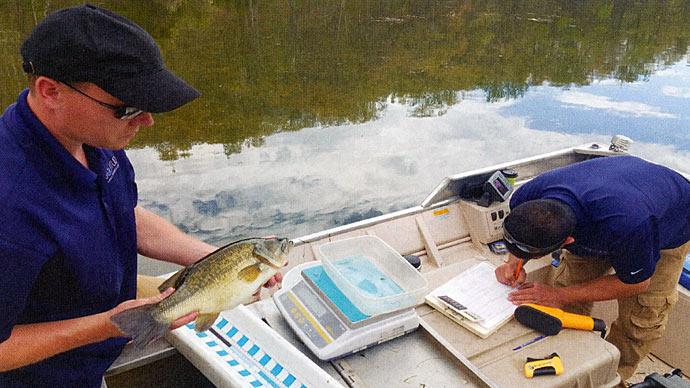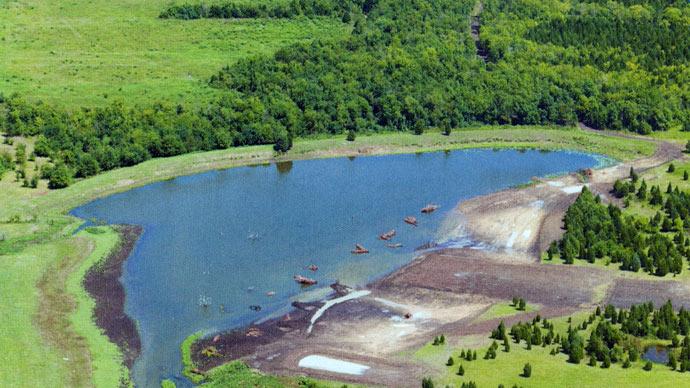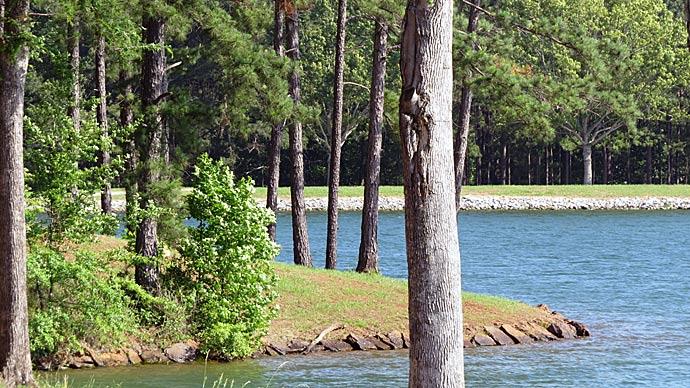
Avid Pond Boss reader and ardent pondmeister, Dave Weber, from northeastern Kansas, attended a Pond Boss forum member gathering this fall in the southeastern part of the state. He posed a thoughtful, interesting question.
"If you were to create a successful pond, what are the top five things you'd do, and in what order?"
Great question. Very thoughtful.
Naturally, I think of water, first. Without healthy, productive water, nothing else matters. But, if you've read these pages for very long, you know that. Water, as the medium, is the basis for life. If a pond has vibrant water, autonomous from top to bottom, with plenty of oxygen, and healthy amounts of beneficial microbes, minerals, metals, and nutrients in it, expect life beneath to be complementary throughout. That word autonomous may throw you a little bit. In the pond management world, aeration is the vehicle to assist water by moving it vertically, so it can do what it does to keep itself healthy, and autonomous. Aeration is a good helper.
During planning phases to build or renovate a pond, most people soon come to understand the pond needs to be sized to its watershed, shouldn't leak much, and its water should be clean and healthy. Without those seminal features, what I'm about to write is irrelevant.
Habitat is the most important element in a successful fishing pond. Think about your favorite fishing holes. What makes them so good? Catch rates? Quality of the fish? Different species you can catch?
Think about habitat as you might think about your car or truck. Get in, buckle up, turn the key, and things click, right? All you have to do is add gas, and do all the routine maintenance— change the oil, keep proper air pressure in the tires, and have all the fluid levels checked from time to time. But, raise the hood and start trying to understand how all those pieces come together to get you from place to place, and things get a little complicated.

Habitat is what you find under the hood of your fishing pond or lake. Lots of people understand the need to attract their big bass or other game fish. I can't tell you how many ponds I've seen where the proud owner has placed a few big logs, maybe some old culverts, a car body, brush piles, and some rocks or concrete blocks in the bottom of their new fishing hole before a drop of water enters it. They've called me to come bless their endeavor—oftentimes at the last minute, after the heavy equipment is gone. Invariably, these new honey holes are missing key elements.
Let's go back to the engine analogy. Without a fuel injector, your truck won't start. Without a water pump, your engine will burn up. Your pond habitat is similar to an engine, fueled by nature. A thriving fishing pond needs diverse habitat to accommodate a necessary diverse fish population. Different sizes of different species of fish go through a variety of phases during their lifespans. Tiny fish need immediate food and small places to hide. If they get eaten too fast, the food chain suffers. Bigger fish have different habitat needs. Think like this: fish need a place to spawn, with safety cover nearby for fry to escape and grow. Bigger fish prefer edge cover with less-dense places to hide from the biggest fish. Those monsters are typically looking for a place to hide and ambush their prey. When you figure out your pond needs to be an underwater community, with diverse habitat covering roughly 20-25% of the pond, mostly in the upper depths, you'll see the engine of your pond run smoothly years down the road.
Excellent habitat provides success to the third most important element in a successful pond. If the baitfishes have the chance to grow large enough to become something bigger than a snack, you'll have a pond that provides an excellent food chain. It takes around ten pounds of aquatic-produced food for a fish to gain a pound. That means your bluegills must eat ten pounds of bugs, small fish, periphyton, worms or whatever their predatory little mouths can find, just to gain a pound. Then, it takes ten pounds of bluegills, minnows, big bugs, and other fish for a bass to gain a pound. When you do the math, it takes quite a bit to fuel the food chain. No groceries, no growth. Sound, diverse habitat provides the opportunity, and the water provides the medium. The food chain responds. It's a consequence. Sure, you can feed your fish, fertilize the water, and add some amendments to beef up productivity and expedite growth rates. That's management. If a pond has great habitat and healthy water, it will hum like the engine that helped you get to work.
Fourth? Good genetics. That's probably the easiest part. Local fish, endemic strains of the target species are important to the success of your pond. I'll always remember, decades ago, when I was on a fish delivery north of Houston, Texas. It was August, the temperature was in the upper 90's, and traffic on 1-45 near Conroe was stop and go. I was coming up on a car in the right lane. I noticed the Alaska license tag. All the windows were rolled down. As I slowly passed that car in heavy traffic, I was struck. Those people, whom I presume were Eskimos, were sweating profusely and almost looked like they were panting. It took a minute, but it registered. These poor folks were driving in a car that didn't have air-conditioning, in rush hour traffic, in Houston, in the hottest month of the year, with humidity pushing the 90% mark. Where they're from, they don't need air conditioning. They were miserable. Not only was the habitat unkind, their genetics weren't helpful in that environment.

If you want to grow big fish, you need the best genetics for that goal. But, don't take pure Florida strain bass to Nebraska and expect them to flourish. Don't take the best walleye strains to south Louisiana and expect huge fish. Good genetics in the wrong environment will most always end in disappointment. Pick the best genetics for your part of the planet.
The fifth biggest thing? Harvest. Look at your pond as a garden. You'll plant it, nurture it, and watch it grow. At some point—you get to decide that point—you'll need to harvest some fish. Based on your goals, harvest the fish which impede your progress. Most of the time, you'll harvest a slot limit—a size class of fish that overeat the food chain in important life phases and sizes of the population as a whole. A classic example of that in a bass lake is to harvest 10-14" bass. Let the bigger ones continue to grow larger as the smaller ones grow into the slot.
If you can take all five of these concepts and blend them together, you'll have a pond engine that will provide fun for years. Your pond will be healthy, productive, and will tend to grow some big fish.
Oh yeah, there's one more big, important item. You. The more you know and understand this engine we call your pond, the more successful your pond will be. Stay with the vehicle analogy for a minute. It's our nature to add gas, buy new tires when needed, and service the vehicle properly, if we intend to keep it. But, if we don't keep our automotive senses aware, we can get hit with some unexpected problems. If the engine whines, knocks, or makes a weird noise, we better check it out. If not, we could be in for major repairs. Same holds true for your pond. The more you learn, the better you can guide your favorite fishing hole.
Debbie and I recently were invited to address a group of county agents in north Texas. The event was held on a ranch, under a pavilion next to a gorgeous 25+ acre lake. As we parked and got out of the truck on the late September day, I smelled a faint, but familiar odor. The wind was in our face, blowing across the lake. That smell was mildly musk-like, a bit fishy with a dash of fleeting rotten egg odor. I paused, looked at the water, saw it was olive-green with a slim line of dead planktonic algae lapping against the limestone riprap along the shore.
That lake was turning over at that moment, releasing trapped gasses from an entire summer beneath the thermocline.
As I began my speech, I asked the crowd, "Did any of you notice a mild odor beside the lake?" Several people nodded in affirmation. I asked them if they knew what it was. Not one of them knew. That's normal—a lake turning over in the fall and people not knowing what it is.
If you'll study what makes the engine of your pond purr, you'll be happier with how it runs. These five keys to a successful pond blend with each other to create a synergy that makes it become what it will ultimately be. Part of your mission is to understand these important concepts and steward them to health and longevity. Or, you can just buckle up, add some gas, and drive the wheels off.
Reprinted with permission from Pond Boss Magazine



